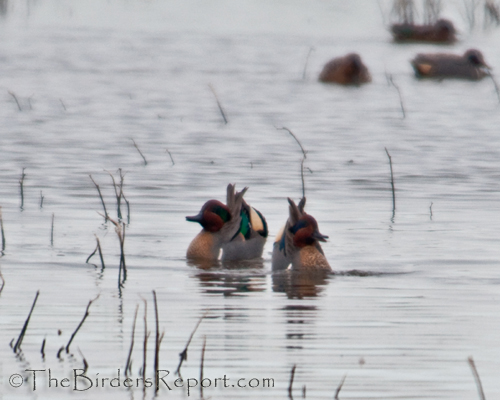Tuesday was my last day off from my job’s spring break, so of course I used my free time to go birding. I went to Amico Island for the second time in a week, this time with Dave’s mother (Dave and I went Friday and saw all sorts of large birds). It was a lovely afternoon; sunny and around 60 degrees.
The area near the parking lot is part of Dredge Harbor, so there’s an area of water right when you walk into the park. It was low tide so the mudflats were exposed. When the tide is higher we usually see Great Blue Herons, gulls, or Mallards in this area. We had a surprise this time.
A flock of Green-winged Teals! There were around 30 of them waddling through the mudflats. They were busily looking for food and leaving trails in the mud. It was unexpected, but a nice start to the walk.

Our first route was the blue trail, which passes by the Great Blue Heron rookery. On the way we saw Downy Woodpeckers, American Robins, and Carolina Chickadees. There were about 7 Great Blue Herons at the rookery. One was bringing a large stick to its nest, while another made low croaking noises. At the rookery observation area we spotted some Yellow-rumped Warblers (my ‘first of year’) hopping between branches.We were so busy watching the warblers that we didn’t notice a Great Blue Heron standing directly below us on the rocks. Its plumage was gorgeous up close and were able to see its striped crown really well (it looked better in person than in the picture I got).

After we left the rookery observation area, I was talking about how I haven’t see any deer my last few visits. Last year Dave and I would frequently see deer when visiting Amico and would almost always see a specific doe and her fawn. The deer must have known I was talking about them: suddenly 10 deer showed up! They noticed us, but quickly relaxed and continued feeding like we weren’t there. It was cool, because I don’t usually see that many deer in a group at one time. It was a nice transition to the second part of the walk.
We continued onto the red and yellow trails, which loop around the pond and lead to the beach entrance. Here we saw Red-winged Blackbirds, Grackles, Crows, and more robins (of course!). It was too windy to walk on the beach, but we did spot some Ring-billed Gulls, Canada Geese, and Mallards. At the pond there was an American Coot preening near a log. It was my first coot sighting at Amico Island.

One thing that was especially exciting for me about this trip was the fact that a new spring migrant arrived: swallows! These little aerial acrobats were fluttering everywhere! Seeing swallows is another spring milestone that I look forward to every year. We mainly saw Tree Swallows, but there may have been some Northern Rough-winged Swallows mixed in. I’m thinking this swallow we watched resting on a branch is a Northern Rough-winged. I’m not 100% on id yet (I will let you know when I figure it out). If it is, then its a new “life bird” for me. It was awfully cute.

Our walk took about 2 hours. When we returned to the parking lot the flock of Green-winged Teals was still feeding, bringing our walk around full circle. It was a nice way to end my spring break.







































